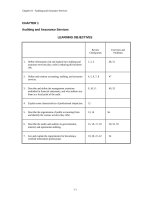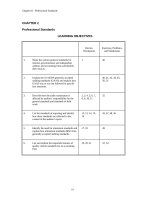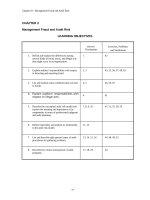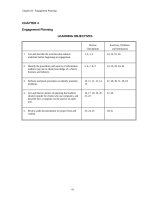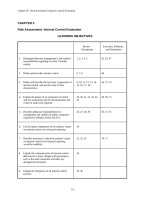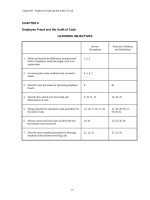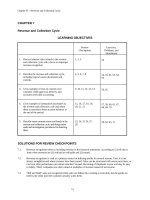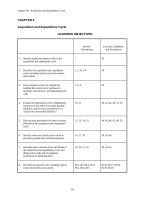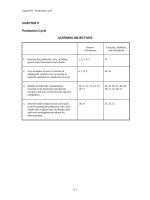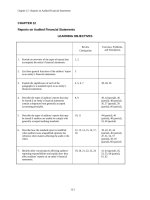Solution manual cost and managerial accounting by barfield 3rd capital budgeting
Bạn đang xem bản rút gọn của tài liệu. Xem và tải ngay bản đầy đủ của tài liệu tại đây (385.02 KB, 35 trang )
Chapter 14
Capital Budgeting
Questions
1.
Capital assets are the longlived assets that are acquired by
a firm. Capital assets provide the essential production and
distributional capabilities required by all organizations.
2.
Each criterion provides different information about projects.
By using multiple criteria, more dimensions of competing
projects can be compared as a basis for allocating scarce
capital to new investment.
3.
Cash flows are the final objective of capital budgeting
investments just as cash flows are the final objective of any
investment. Accounting income ultimately becomes cash flow but
is reported based on accruals and other accounting assumptions
and conventions. These accounting practices and assumptions
detract from the purity of cash flows and are, therefore, not
used in capital budgeting.
4.
Analysts separate the act of financing a business's many
integrated investments and the related financing cash flows
from the selection of capital projects and the cash flows
related to such selections because of the virtual
impossibility of convincingly assigning dollars obtained from
the many general financing sources to the particular projects
being selected during a given year.
5.
Timelines provide clear visual models of the expected cash
inflows and outflows for each point in time for a project.
They provide an efficient and effective means to help organize
the information needed to perform capital budgeting analyses.
6.
The payback method measures the time expected for the firm to
recover its investment. The method ignores the receipts
expected to occur after the investment is recovered and
ignores the time value of money.
113
114
Chapter 14
Capital Budgeting
7.
The time value of money is important because having a sum of
money now allows a company to earn a return on it; if the same
amount were not received until some time in the future, a
return could not be earned on it between now and the time it
is received. All else being equal, managers prefer to have
cash receipts now rather than in the future and would prefer
to make cash disbursements in the future rather than now.
Future values can be converted into equivalent present values
by the process of discounting. The following methods use the
time value of money concept: net present value, internal rate
of return, and the profitability index. The accounting rate of
return and payback period do not use the time value of money
concept.
8.
Return of capital means the investor is receiving the
principal that was originally invested. Return on capital
means the investor is receiving an amount earned on the
investment.
9.
The NPV of a project is the present value of all cash inflows
less the present values of all outflows associated with a
project. If the NPV is zero, it is acceptable because, in
that case, the project will exactly earn the required cost of
capital rate of return. Also, when NPV equals zero, the
project’s internal rate of return equals the cost of capital.
10.
It is highly unlikely that the estimated NPV will exactly
equal the actual NPV achieved because of the number of
estimates necessary in the original computation. These
estimates include the project life, the discount rate chosen
and the timing and amounts of cash inflows and outflows. The
original investment may also include an estimate of the amount
of working capital that is needed at the beginning of the
project life.
11.
The NPV method subtracts the initial investment from the
discounted net cash inflows to arrive at the net present
value. The PI divides the discounted cash inflows by the
initial investment to arrive at the profitability index. Thus,
each computation uses the same set of amounts in different
ways. The PI model attempts to measure the planned efficiency
of the use of the money (i.e., output/input) in that it
reflects the expected dollars of discounted cash inflows per
dollar of investment in the project.
12.
The PI will exceed 1 only in instances where the net present
value exceeds 0. This is because the NPV is positive only if
the present value of cash inflows exceeds the present value of
cash outflows. Similarly, the present value of cash inflows
must exceed the present value of cash outflows if the
numerator of the PI formula is to exceed the denominator.
Chapter 14
Capital Budgeting
115
116
Chapter 14
Capital Budgeting
13.
The IRR is the rate that would cause the NPV of a project to
equal zero. A project is considered potentially successful
(all other factors being acceptable) if the calculated IRR
exceeds the company's cost of capital.
14.
On any prospective project, when the NPV exceeds zero, the
project's IRR will exceed the firm's discount rate that was
used to find the NPV. If the IRR equals the firm's discount
rate, the NPV will equal zero. If the IRR is less than the
firm's discount rate, the NPV will be negative. This
relationship holds true because, ultimately, under either
method the calculations for project selection are designed to
hinge on the project's cash flows in relation to the firm's
discount rate.
15.
The amount of depreciation for a year is one factor that helps
determine the amount of cash outflow for income taxes.
Therefore, although depreciation is not a cash flow item
itself, it does affect the size of another item (income taxes)
that is a cash flow.
16.
The tax shield is the amount of revenue on which the
depreciation prevents taxation. The tax benefit is the tax
that is saved because of the depreciation and is found by
multiplying the company's tax rate by the tax shield provided
by depreciation.
17.
The four questions are:
1. Is the activity worthy of an investment?
2. Which assets can be used for the activity?
3. Of the assets available for each activity, which is the best
investment?
4. Of the best investments for all worthwhile activities, in
which ones should the company invest?
18.
NPV: Ranks projects in descending order of magnitude.
PI: Ranks projects in descending order of magnitude if a
positive cash flow project.
IRR: Ranks projects in descending order of magnitude.
Payback: Ranks projects in ascending order of magnitude.
ARR: Ranks projects in descending order of magnitude.
19.
Several techniques should be used because each technique
provides valuable and different information. Of preferred use
as the primary evaluator is the net present value in
conjunction with the present value index, because management's
goal should be to maximize, within budget and risk
constraints, the net present value of the firm.
Chapter 14
Capital Budgeting
117
20.
Capital rationing exists because a firm often finds that it
has the opportunity to invest in more acceptable projects than
it has money available. Projects are first screened as to
desirability and then ranked as to impact on company
objectives.
21.
Risk is defined as the likely variability of the future
returns of an asset. Aspects of a project for which risk is
involved are:
* Life of the asset
* Amount of cash flows
* Timing of cash flows
* Salvage value of the asset
* Tax rates
When risk is considered in capital budgeting analysis, the NPV
of a project is lowered.
22.
Sensitivity analysis is used to determine the limits of value
for input variables (e.g., discount rate, cash flows, asset
life, etc.) beyond which the project's outcome will be
significantly affected. This process gives the decision maker
an indication of how much room there is for error in estimates
for input variables and which input variables need special
attention.
23.
Postinvestment audits are performed for two reasons: to
obtain feedback on past projects and to make certain that the
champions of proposed projects submit realistic numbers
knowing their estimates will ultimately be compared to actual
numbers. These audits can provide information to correct
problems and to assess how well the capital investment
selection process is working. The larger the capital
expenditure, the more important it is to perform
postinvestment audits. Postinvestment audits are performed at
the completion of a project.
24.
The time value of money refers to the concept that money has
timebased earnings power. Money can be loaned or invested to
earn an expected rate of return. Present value is always less
than future value because of the time value of money. A
future value must be discounted to determine its equivalent
(but smaller) present value. The discounting process strips
away the imputed rate of return in future values, thus
resulting in smaller present values.
25.
An annuity is a cash flow that is repeated in successive
periods. Single cash flows occur only in one period.
118
26.
Chapter 14
Capital Budgeting
ARR = Average annual profits ÷ Average investment
Unlike the rate used to discount cash flows or to compare
to the cost of capital rate, the ARR is not a discount rate to
apply to cash flows. It is measured from accrualbased
accounting information and is not intended to be associated
with cash flows.
Exercises
27. a. 3
b. 10
c. 2
d. 9
e. 5
f. 8
g. 6
h. 4
i. 1
j. 7
28.
a. 9
b. 4
c. 7
d. 3
e. 6
f. 5
g. 10
h. 2
i. 8
j. 1
29.
a.
Payback = $750,000 ÷ $150,000 per year = 5.00 years
Year
1
2
3
4
5
6
7
8
9
b.
Amount
Cumulative Amount
$ 75,000 $ 75,000
75,000 150,000
75,000 225,000
75,000 300,000
75,000 375,000
100,000 475,000
100,000 575,000
100,000 675,000
100,000 775,000
Payback = 8 + ($75,000 ÷ $100,000) years
= 8.75 years, or 8 years and 9 months
Chapter 14
Capital Budgeting
30.
a.
Year
1
2
3
4
5
6
7
Amount
$ 5,000
9,000
16,000
18,000
15,000
14,000
12,000
119
Cumulative Amount
$ 5,000
14,000
30,000
48,000
63,000
77,000
89,000
Payback = 4 years + ($12,000 ÷ $15,000)
= 4.8 years
b.
Yes. Bach’s should also use a discounted cash flow
technique for two reasons: (1) to take into account the
time value of money and (2) to consider those cash flows
that occur after the payback period.
Point in time Cash flows PV Factor Present Value
0 $(400,000) 1.0000 $(400,000)
1 70,000 0.8929 62,503
2 70,000 0.7972 55,804
3 85,000 0.7118 60,503
4 85,000 0.6355 54,018
5 85,000 0.5674 48,229
6 86,400 0.5066 43,770
7 86,400 0.4524 39,087
8 86,400 0.4039 34,897
9 62,000 0.3606 22,357
10 62,000 0.3220 19,964
NPV $ 41,132
31.
Based on the NPV, this is an acceptable investment.
32.
a.
The contribution margin of each part is $28 ($50 $22)
Contribution margin per year = $28 × 50,000 = $1,400,000
Point in time Cash flows PV factor Present Value
0 $ (500,000) 1.0000 $ (500,000)
1 8
(40,000) 5.7466 (229,864)
1 8 1,400,000 5.7466 8,045,240
NPV $7,315,376
b.
Based on the NPV, this is a very acceptable investment.
120
Chapter 14
Capital Budgeting
c.
Other considerations would include whether the company
has the necessary capacity to produce the additional
output, the possibility that the customer would decide to
purchase elsewhere or would no longer have need for the
parts after Machado Industrial has made its investment,
and whether the company has considered all of the costs
that would be affected by the decision to produce the new
part—especially labor and overhead.
33.
PI = PV of cash inflows PC of cash outflows
= ($6,000 + $30,000) $30,000 = 1.20
34.
a.
PV of inflows $590,489 ($88,000 6.7101)
PV of investment $500,000
PI = $590,489 ÷ $500,000 = 1.18
b.
The OTA should accept the project because its PI is
greater than 1.00.
c.
To be acceptable, a project must generate a PI of at
least 1.
a.
PV = discount factor annual cash inflow
$140,000 = discount factor $28,180
Discount factor = $140,000 ÷ $28,180 = 4.968
The IRR is 12%
b.
Yes. The IRR on this proposal is greater than the firm's
hurdle rate of 10%.
c.
$140,000 = 5.335 Cash flow
Cash flow = $26,242
a.
Year
Amount
Cumulative Amount
1
$14,000
$ 14,000
2
14,000
28,000
3
11,000
39,000
4
11,000
50,000
Payback = 4 years + (52,000 50,000) $9,000
= 4.22 years
35.
36.
Point in time Cash flows PV Factor Present Value
0 $(52,000) 1.0000 $(52,000)
1 2 14,000 1.7356 24,298
3 4 11,000 1.4343 15,777
5 6 9,000 1.1854 10,669
6 7,500 0.5645 4,234
NPV $ 2,978
b.
Chapter 14
Capital Budgeting
c.
PI = ($52,000 + $2,978) $52,000 = 1.06
121
122
37.
Chapter 14
Capital Budgeting
a.
b.
Investment ÷ Annual Savings = $2,300,000 ÷ $300,000 =
7.67 years.
Point in Time Cash Flows PV Factor Present Value
0 $(2,300,000) 1.0000 $(2,300,000)
1 11 300,000 6.4951 1,948,530
NPV $ (351,470)
c.
PI = $1,948,530 ÷ $2,300,000 = 0.85
d.
PV = discount factor annual cash inflow
$2,300,000 = discount factor $300,000
discount factor = $2,300,000 ÷ $300,000 = 7.6667
discount factor of 7.6667 corresponds to an IRR ≈ 7%
Straightline method
Annual depreciation = $1,000,000 ÷ 5 years
= $200,000 per year
Tax benefit = $200,000 0.35 = $70,000
PV = $70,000 3.7908 = $265,356
38.
a.
b.
Accelerated method
$1,000,000 0.40 0.35 .9091 = $127,274.00
$ 600,000 0.40 0.35 .8265 = 69,426.00
$ 360,000 0.40 0.35 .7513 = 37,865.52
$ 216,000 0.40 0.35 .6830 = 20,653.92
$ 129,600* 0.35 .6209 = 28,164.02
Total $283,383.46
*
In the final year, the remaining undepreciated cost is
expensed.
c.
The depreciation benefit computed in part (b). exceeds that
computed in part (a). solely because of the time value of
money. The depreciation method in part (b). allows for
faster recapture of the cost; therefore, there is less
discounting of the future cash flows.
123
Chapter 14
Capital Budgeting
39.
a. SLD = $40,000,000 ÷ 8 years = $5,000,000 per year
Beforetax CF
$8,400,000
Less depreciation
5,000,000
Beforetax NI $3,400,000
Less tax (30%) 1,020,000
NI
$2,380,000
Add depreciation
5,000,000
Aftertax CF
$7,380,000
Point in Time Cash Flows PV Factor Present Value
0 $(40,000,000) 1.0000 $(40,000,000)
1 8 7,380,000 5.7466 42,409,908
NPV $ 2,409,908
The project is acceptable.
b.
Beforetax CF
Less Depreciation
Beforetax NI
Tax (tax benefit)
Aftertax NI
Add Depreciation
Aftertax CF
Years 1 and 2
$ 8,400,000
9,200,000
$ (800,000)
(240,000)
$ (560,000)
9,200,000
$ 8,640,000
Years 38
$8,400,000
3,600,000
$4,800,000
1,440,000
$3,360,000
3,600,000
$6,960,000
Point in time Cash flows PV factor Present Value
0 $(40,000,000) 1.0000 $(40,000,000)
1 2 8,640,000 1.7833 15,407,712
3 8 6,960,000 3.9633 27,584,568
NPV $ 2,992,280
The project is acceptable.
124
Chapter 14
Capital Budgeting
c.
Recomputation of part (a):
Beforetax CF
$8,400,000
Less depreciation
5,000,000
NIBT
$3,400,000
Less tax (50%) 1,700,000
NI
$1,700,000
Add depreciation
5,000,000
Aftertax CF
$6,700,000
Point in Time Cash Flows PV Factor Present Value
0 $(40,000,000) 1.0000 $(40,000,000)
1 8 6,700,000 5.7466 38,502,220
NPV $ (1,497,780)
The project is not acceptable.
Recomputation of part (b):
Years 1 and 2
Beforetax CF
$ 8,400,000
Less Depreciation
9,200,000
NIBT
$ (800,000)
Less Tax(tax benefit) (400,000)
Aftertax NI
$ (400,000)
Add Depreciation
9,200,000
Aftertax CF
$ 8,800,000
Years 38
$8,400,000
3,600,000
$4,800,000
2,400,000
$2,400,000
3,600,000
$6,000,000
Point in Time Cash Flows PV Factor Present Value
0 $(40,000,000) 1.0000 $(40,000,000)
1 2 8,800,000 1.7833 15,693,040
3 8 6,000,000 3.9633 23,779,800
NPV $ (527,160)
The project is not acceptable.
40. a.
Tax: $25,000 $8,000 = $17,000
Financial accounting: $25,000 $15,000 = $10,000
b.
CFAT = Market value now minus taxes
= $17,000 (($17,000 $8,000) .40)
= $13,400
c.
CFAT = $4,000 (($4,000 $8,000) .40) = $5,600
Chapter 14
Capital Budgeting
41.
a.
125
Find the rate that will cause the NPVs of the two
projects to be equal. By trial and error, the
indifference rate is just above 4%. At a 4% rate the NPV
of each project is computed as follows:
Project 1:
NPV = (8.1109 $85,000) $400,000
NPV = $289,427
Project 2:
NPV = (8.1109 $110,000) $600,000
NPV = $292,199
b.
This rate is known as the Fisher rate.
c.
Project 1:
NPV = (5.6502 $85,000) $400,000
NPV = $80,267
Project 2:
NPV = (5.6502 $110,000) $600,000
NPV = $21,522
Project 1 would be preferred due to its higher NPV,
42.
43.
a.
cash flow annuity factor = $30,000
cash flow 3.6048 = $30,000
cash flow = $8,322
b.
$30,000 ÷ $8,322 = 3.6 years
PV factor $180,000 = $400,000
PV factor = $400,000 ÷ $180,000 = 2.2222
This factor falls between 1.7591 (at 2 years) and 2.5313 (at 3
years) in the table using the 9% column. Thus, the cash flow
would have to persist for over 2 years but under 3 years.
44.
a.
cash flow discount factor = investment
cash flow 7.1607 = $1,200,000
cash flow = $167,581
b.
cash flow discount factor = investment
$193,723 discount factor = $1,200,000
discount factor = 6.1944
This PV factor for 12 periods corresponds to 12%.
126
45.
Chapter 14
Capital Budgeting
future value × discount factor = present value
future value × .5674 = $14,000
future value = $24,674
46. Cost = $9,000 + PV($1,200 annuity)
= $9,000 + ($1,200 × 30.1075)
= $45,129
47. a.
PV = future value × discount factor
= $50,000 .6302
= $31,510 should be invested to achieve the goal
b.
PV = future value discount factor
= $200,000 .3083
= $61,660 would be equivalent today
c.
PV = future value discount factor
= $60,000 .3522
= $21,132
timeline
time t0 t1 t2 t3 t4 t5
amount $210 $210 $210 $210 $210
d.
Year 1 receipt: $210,000 × .9246 = $194,166
Year 2 receipt: $210,000 × .8548 = 179,508
Year 3 receipt: $210,000 × .7903 = 165,963
Year 4 receipt: $210,000 × .7307 = 153,447
Year 5 receipt: $210,000 × .6756 = 141,876
Present value $834,960
Discount factors based on semiannual rate of 4 percent.
e.
Year 1 receipt: $ 30,000 .9259 = $ 27,777
Year 2 receipt: $ 50,000 .8573 = 42,865
Year 3 receipt: $ 60,000 .7938 = 47,628
Year 4 receipt: $100,000 .7350 = 73,500
Year 5 receipt: $100,000 .6806 = 68,060
Year 6 receipt: $100,000 .6302 = 63,020
Year 7 receipt: $100,000 .5835 = 58,350
Year 8 receipt: $100,000 .5403 = 54,030
Year 9 receipt: $ 70,000 .5003 = 35,021
Year 10 receipt: $ 45,000 .4632 = 20,844
Present value $491,095
f. No. Using any discount rate above 0, the present value
of the future annual cash flows is well below $1,000,000.
Only if the friend has substantial other assets would she
Chapter 14
Capital Budgeting
be a millionaire.
127
128
Chapter 14
Capital Budgeting
48. a.
Change in net income = $250,000 ($500,000 ÷ 5)
= $150,000
ARR = $150,000 ÷ ($500,000 ÷ 2) = 60%
Payback = $500,000 ÷ $250,000 per year = 2 years
49.
b.
Yes. The equipment investment meets all investment
criteria. The payback is less than 5 years and the
accounting rate of return exceeds 18%.
a.
Annual cash receipts $16,000
Cash expenses (2,000)
Net cash flow before taxes $14,000
Depreciation 8,333
Income before tax $ 5,667
Taxes (1,983)
Net income $ 3,684
Depreciation 8,333
Annual aftertax cash flow $12,017
b.
Payback = $50,000 $12,017 per year = 4.16 years
c.
ARR = $3,684 ($50,000 2) = 14.74%
a.
Beforetax cash flow
Depreciation ($60,000 ÷ 5)
Income before tax
Tax (28%)
Net income
Depreciation
Annual aftertax cash flow
b.
c.
Point in time Cash flows PV factor Present Value
0 $(60,000) 1.0000 $(60,000)
15 $ 21,360 3.7908 80,971
NPV $ 20,971
From part a. accounting income = $9,360
d.
ARR = $9,360 ÷ (($60,000 + $0) ÷ 2) = 31.2%
50.
$ 25,000
(12,000)
$ 13,000
(3,640)
$ 9,360
12,000
$ 21,360
Payback = $60,000 $21,360 = 2.81 years
Chapter 14
Capital Budgeting
51.
129
a.
Payback = $750,000 $250,000 annually = 3 years
b.
One of the other cost savings may come in the form of
improved quality. By adopting the higher technology,
fewer defects should occur. Additionally, the company
may be able to lower its costs because of its enhanced
flexibility to switch production from one job to another.
Additional costs may come in the form of maintenance and
repairs as well as training costs to upgrade skills of
workers to operate the new equipment.
52. Some of the factors that would weigh in favor of proceeding
with the investment as planned include these:
The cost savings will be received now instead of later.
Any learning curve effects will be enjoyed earlier.
Any quality effects on operations will be recognized sooner.
The reduced maintenance cost benefit will occur now rather
than later.
Demand for services may accelerate unexpectedly.
Delays in installing the equipment may result in price hikes
that could be avoided if the equipment is installed on
schedule.
The factors that might weigh in favor of delaying investment
include these:
Risk associated with the new investment may increase because
of the likelihood that demand will not pick up in the near
future.
Possible price reductions might be realized by delaying
acquisition of the equipment. Price reductions are more
likely on computerized equipment.
Possible layoffs of employees can be deferred.
More time is now available to evaluate alternative
technologies that may have emerged or will emerge soon.
The company should protect its cash flow in light of a
local, stagnating economy.
130
53.
Chapter 14
Capital Budgeting
A company’s R&D program is the major source of distant, future
cash flows. It is from the R&D effort that new products are
identified and developed. Without a successful R&D program,
the stream of future cash flows will dry up. Similarly, the
present products and services offered by a firm are
attributable to past R&D programs. Hence, the linkage is
established between R&D activity, and present and future cash
flows.
It is not surprising that much longterm planning should
be concentrated on the R&D activity. Managing the investment
in R&D activities is the main method available to managers to
balance current and present cash flows, as well as present and
future growth. R&D is expensed when incurred and this reduces
current earnings. This often tends to depress stock prices.
54. The capital budget interacts with the cash budget in that
acquisition of capital items represents a use of cash. The
capital budget also interacts with the statement of cash flows
investing activities section. Further, the capital budget
impacts depreciation expense on the budgeted income statement,
and assets on the budgeted balance sheet. Indirectly, the
capital budget interacts with other lines on the income
statement because the various projects included in the capital
budget will influence a variety of expenses including labor,
overhead, administration and marketing.
55. No response provided.
56.
The market must be expecting an enormous increase in future
cash flows relative to current cash flows. If the total value
of the shares is viewed as the present value of the future
cash flows accruing to the equity holders, the only possible
explanation for the incredibly high value of the stock is that
investors expect future cash flows to be many times the level
of current cash flows.
57.
If the value of a share of stock is viewed as the present
value of the future cash flows that will accrue to that share
of stock, then any change in the discount rate applied by
investors would affect the share price. If interest rates
move up and down, it is reasonable to expect stock prices to
move inversely to the change in interest rates because the
change in the prevailing interest rates represents a change in
the discount rate applied by investors.
Chapter 14
Capital Budgeting
58.
131
The capital budget is a key control tool for a .com firm. Few
.com firms have turned a profit yet. They are very early in
the process of developing products and services to deliver
over the Internet and this process requires substantial
capital investment. Consequently, their investing activities,
managed by the capital budgeting process, are the focus of
much managerial time and talent. Only if these firms invest
in the right projects will the eventual success of the firm be
realized.
Problems
59.
a. ($000s omitted)
t0
t1
t2 t3 t4 t5 t6 t7 t8
Investment 90.0
New CM 24.00 24.0 24.0 24.0 24.00 24.00 24.00 24.00
Oper. costs 0.0 6.50 7.2 7.2 7.2 7.95 9.45 10.00 11.25
Ann. savings 90.0 17.50 16.8 16.8 16.8 16.05 14.55 14.00 12.75
Year
Cash Savings
Cumulative Savings
1
$17,500
$17,500
2
16,800
34,300
3
16,800
51,100
4
16,800
67,900
5 16,050 83,950
Payback = 5 + (($90,000 $83,950) $14,550) = 5.42 years
b.
c.
60. a.
Time Cash Flow PV Factor for 10% Present Value
0
$(90,000)
1.0000
$(90,000)
1
17,500
.9091
15,909
2
16,800
.8265
13,885
3
16,800
.7513
12,622
4
16,800
.6830
11,474
5
16,050
.6209
9,965
6
14,550
.5645
8,213
7
14,000
.5132
7,185
8
12,750
.4665
5,948
NPV
$(4,799)
Time: t0 t1 t2 t3 t4 t5 t6 t7
Amount: ($31,000) $6,800 $7,100 $7,300 $7,000 $7,000 $7,100 $7,200
b. Year Cash Flow Cumulative
Year 1 $6,800 $ 6,800
Year 2 7,100 13,900
Year 3 7,300 21,200
Year 4 7,000 28,200
Payback = 4 years + (($31,000$28,200)$7,000) = 4.40 years
132
Chapter 14
Capital Budgeting
c.
Cash flow Discount Present
Description Time Amount Factor Value
Purchase the car t0 ($31,000) 1.0000 ($31,000)
Cost savings t1 6,800 .8929 6,072
Cost savings t2 7,100 .7972 5,660
Cost savings t3 7,300 .7118 5,196
Cost savings t4 7,000 .6355 4,448
Cost savings t5 7,000 .5674 3,972
Cost savings t6 7,100 .5066 3,597
Cost savings t7 7,200 .4524 3,257
NPV $ 1,202
61.
a.
Payback period = $64,000 ÷ ($25,000 $4,500) = 3.12
years; the project does meet the payback criterion.
b.
Discount factor = Investment ÷ annual cash flow
= $64,000 ÷ $20,500 = 3.1220
Discount factor of 3.1220 indicates IRR > 10.5%
which is an unacceptable IRR. The actual IRR is 10.71%.
Year
Cash flow
PV factor
PV
0
$(2,500,000)
1.0000 $(2,500,000)
17 419,500
5.0330 2,111,344
7 200,000 .5470 109,400
NPV
$ (279,256)
62.
a.
b.
No, the NPV is negative; therefore this is an
unacceptable project.
c.
PI = ($2,111,344 + $109,400) ÷ $2,500,000
= 0.89
d.
The company should consider the quality of the work
performed by the machine versus the quality of the work
performed by the individuals; the reliability of the
manual process versus the reliability of the mechanical
process; and perhaps most importantly, the effect on
worker morale and the ethical considerations in
displacing 14 workers.
Chapter 14
Capital Budgeting
63.
a.
133
The incremental cost of the new machine: $290,000 $6,000
= $284,000
Cash flow Discount Present
Description Time Amount Factor Value
Incremental cost t0 $(284,000) 1.0000 $(284,000)
Cost savings t1t7 60,000 4.9676 298,056
NPV
$ 14,056
PI = $298,056 ÷ $284,000 = 1.05
Yes, the machine should be purchased because the NPV > 0
and the PI > 1.
b.
Payback = $284,000 ÷ 60,000 per year = 4.73 years
c.
Net investment ÷ annual annuity = discount factor of IRR
$284,000 ÷ 60,000 = 4.7333
Discount factor of 4.7333 is between 13.0 and 13.5%
Using interpolation, the actual rate is 13.40%
64.
a.
Computation of net annual cash flow:
Increase in revenues $172,000
Increase in cash expenses (75,000)
Increase in pretax cash flow $ 97,000
Less Depreciation (39,000)
Income before tax $ 58,000
Income taxes (30 percent) (17,400)
Net income $ 40,600
Add Depreciation 39,000
Aftertax cash flow $ 79,600
Cash Flow Discount Present
Description Time Amount Factor Value
Initial cost t0 $(780,000) 1.0000 $(780,000)
Annual cash flow t1t20 79,600 7.9633 633,879
NPV
$(146,121)
b.
No, this is not an acceptable investment. The net
present value is not close to the cutoff value of $0.
134
Chapter 14
Capital Budgeting
c.
Minimum annual cash flow discount factor =
$780,000
Minimum annual cash flow 7.9633 = $780,000
Minimum annual cash flow = $97,949
Aftertax cash flow increase = Minimum cash flow
Actual cash flow
Aftertax cash flow increase = $97,949 $79,600
Aftertax cash flow increase = $18,349
Increase in revenues = Aftertax cash flow increase ÷ (1
tax rate)
Increase in revenues = $18,349 ÷ 0.70
Increase in revenues = $26,213
Cash flow after tax (CFAT):
Year Pretax CF Depreciation Tax CFAT
1 $52,000 $32,000 $6,000 $46,000
2 59,000 51,200 2,340 56,660
3 59,000 30,400 8,580 50,420
4 51,000 24,000 8,100 42,900
5 43,000 22,400 6,180 36,820
65.
a.
Timeline:
t0 t1 t2 t3 t4 t5
$(160,000) $46,000 $56,660 $50,420 $42,900 $36,820
b.
Year Net Cash Flow Cumulative Cash Flow
1 $46,000 $ 46,000
2 56,660 102,660
3 50,420 153,080
Payback = 3 years + (($160,000153,080) $42,900)
= 3.16 years.
Net present value:
Time Amount Discount Factor Present Value
Year 0 $(160,000) 1.0000 $(160,000)
Year 1 $46,000 .9259 42,591
Year 2 56,660 .8573 48,575
Year 3 50,420 .7938 40,023
Year 4 42,900 .7350 31,532
Year 5 36,820 .6806 25,060
NPV $ 27,781
Profitability index = ($160,000 + $27,781) ÷ $160,000 =
1.17
IRR, is between 14.5% and 15%. Using a computer, the IRR
is found to be 14.68%.
Chapter 14
Capital Budgeting
66.
a.
Maple Commercial Plaza:
t0 t1t10 t10
$(800,000) $210,000 $400,000
High Tower:
t0 t1t10 t10
$(3,400,000) $830,000 $1,500,000
b.
Maple Commercial Plaza:
Calculation of annual cash flow:
Pretax cost savings $210,000
Depreciation ($800,000 25) (32,000)
Pretax income $178,000
Taxes (40 percent) (71,200)
Aftertax income $106,800
Depreciation 32,000
Aftertax cash flow $138,800
t0 t1t10 t10
$(800,000) $138,800 $432,000*
*
Includes $32,000 from tax loss on sale
(0.40 ($400,000 $480,000))
High Tower:
Calculation of annual cash flow:
Pretax cost savings $ 830,000
Depreciation ($3,400,000 25) (136,000)
Pretax income $ 694,000
Taxes (277,600)
Aftertax income $ 416,400
Depreciation 136,000
Aftertax cash flow $ 552,400
t0 t1t10 t10
$(3,400,000) $552,400 $1,716,000*
*
Includes $216,000 from tax loss on sale
(0.40 ($1,500,000 $2,040,000))
135
136
Chapter 14
Capital Budgeting
c.
d.
Aftertax NPV, Maple Commercial Plaza:
Amount Discount Factor Present Value
Year 0 $(800,000) 1.0000 $(800,000)
Year 110 138,800 5.8892 817,421
Year 10 432,000 .3522 152,150
NPV $ 169,571
Aftertax NPV, Hightower:
Amount Discount Factor Present Value
Year 0 $(3,400,000) 1.0000 $(3,400,000)
Year 110 552,400 5.8892 3,253,194
Year 10 1,716,000 .3522 604,375
NPV $ 457,569
Based on the NPV criterion, Hightower is the preferred
investment
Aftertax NPV, Hightower:
Amount Discount factor Present Value
Year 0 $(3,400,000) 1.0000 $(3,400,000)
Year 110 180,400 5.8892 1,062,412
Year 110 372,000* 4.1925
1,559,610
Year 10 1,716,000 .3522
604,375
NPV
$ (173,603)
Rental portion of cash flow = $620,000 (1 tax rate)
= $620,000 0.60
= $372,000
*
Under this circumstance, Maple Commercial Plaza is the
preferred investment.
137
Chapter 14
Capital Budgeting
67.
a.
Project A
Year Cash Flow PV Factor
0
$(96,000)
1.0000
16
25,600
4.1114
NPV
PV
$(96,000)
105,252
$ 9,252
PI = $105,252 ÷ $96,000 = 1.10
IRR: Discount factor for 6 periods is $96,000 ÷ $25,600 =
3.7500, which yields a rate of just under 15.5%.
Year
0
110
NPV
Project B
Cash Flow
PV Factor
$(160,000)
1.0000
30,400
5.6502
PV
$(160,000)
171,766
$ 11,766
PI = $171,766 ÷ $160,000 = 1.07
IRR: Discount factor for 6 periods is $160,000 ÷ $30,400
= 5.2631, which yields a rate of about 13.75%.
b.
Although the methods give conflicting results, the NPV of
B is greater than that of A and this is probably the best
indication for choice. Although the IRR for Project A is
higher, the reinvestment assumption of that method is
less attainable. Even though the PI of Project A is
slightly higher, its NPV is less and usually dollars are
the deciding criterion when rates are close.
c.
Project A's IRR is 15.5% and Project B's is 13.75%. Above
13.75%, Project B will have a negative NPV. At 12%,
Project A's NPV is $9,252 and Project B's is $11,766. By
repeated trials, the Fisher rate (the rate at which the
NPVs are equal) is estimated to be between 12.50% and
13.0%. By programmable calculator, the rate is found to
be 12.64%.
